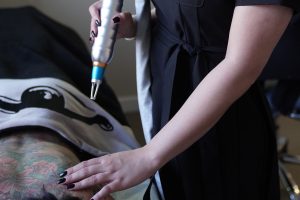
Alabama has about 1.5 million* tattooed individuals. Thinking of entering the tattoo removal business in Alabama? Read through this article to get a grasp on everything you need to know before starting this new venture.
Tattoo Removal Business Start Up
When starting a tattoo removal business, there are several crucial things to consider, plan, and implement. For a step-by-step guide to starting a tattoo removal business, click here. The business will also require insurance coverage. For a detailed analysis of which insurance covers the business will need, click here.
It ultimately comes down to this: laser tattoo removal.
Laser removal has emerged as the go-to treatment. It is effective and comparatively safe, being a non-invasive skin treatment. A laser tattoo removal clinic can be a highly profitable business.
Tattoo Removal Market

Not everyone loves their tattoo forever. According to Harris Poll, almost a quarter of people with tattoos suffer from tattoo regret. In fact, the tattoo removal market is currently witnessing a huge expansion. It is set to grow into a $795 million market by 2027 at a growth rate of 19.3% (Allied Market Research). 1.5 million people in Alabama have at least one tattoo. Many of these 1.47 million will face tattoo regret too. And when they do start looking for removal options, your tattoo removal business in Alabama can emerge as their savior.
Alabama State Laws on Tattoo Removal
In Alabama, the Alabama Board of Medical Examiners lays down rules and regulations concerning the ‘use of lasers and other modalities affecting living tissue’ (Chapter 540-X-11).
According to the board, all ‘ablative’ procedures must be performed by physicians only. Non-ablative procedures can be delegated. These two terms describe two different types of laser/pulsed light treatments. As outlined by the American College of Surgeons (ACOS), an ablative procedure is ‘expected to excise, burn, or vaporize the skin below the dermo-epidermal junction’. Any procedure that can cause damage to the eye also falls under this category. Non-ablative procedures include “any laser/intense pulsed light treatment or other energy source, chemical or modality that is not expected or intended to remove, burn, or vaporize tissue.” Laser hair removal and other related procedures come under this category.
The Board states that,
“If the physician provides on-site supervision, the physician may delegate the performance of non-ablative treatment through the use of written protocols to a properly trained delegate acting under adequate supervision.”
First of all, when a physician provides such services in facilities outside hospitals, she/he is required to register with the Board (see here: https://www.albme.org/Documents/Forms/laserregis.pdf).
 Via: medium.com
Via: medium.com
The physician must also conduct the patient’s initial examination, prepare the treatment plan, and sign off the patient’s chart. After this, she/he can hand over the procedure to a Level 1 or Level 2 delegate. A Level 1 delegate is a mid-level practitioner (an assistant to physician or an advanced practice nurse) who has been authorized to use a given device for a non-ablative procedure. A Level 2 delegate can be anyone with the necessary qualifications. The board has set qualifying requirements for each group. Physicians and Level 1 delegates must have at least 16 hours of basic training. This must include a comprehensive study of the principle of lasers and other non-ablative devices (thermal, IPL, radiofrequency, etc.), clinical applications of its various wavelengths, their instrumentation, physiological effects, and safety protocols. They must also have hands-on clinical experience. Maintenance of competence through documented training and experience is essential. As for Level 2 delegates, they are required to have academic and clinical training in areas like fundamentals of laser operation, bio-effects of laser radiation, laser and laser system classifications, etc. They must complete 16 hours of initial training as well as 10 procedures of preceptee training in each type of non-ablative treatment. They must also maintain their competence for continuing work. An alternative physician must be present for supervision in case the delegating physician is unavailable. A Level 1 delegate may perform the procedure even when the supervising physician is not on site. This is not true for Level 2 delegates. The board also expects the laser operator to abide by OSHA (Occupational Safety and Health Administration) regulations, standards, and guidelines for the safe use of lasers.
These treatments are ultimately the legal and professional responsibility of the physician. The physician is also responsible for the assurance and continuous improvement of treatment quality.
For more information, visit: http://www.alabamaadministrativecode.state.al.us/docs/mexam/McWord11mexam.pdf
Note: This article does not offer legal advice.
>> Tattoo Removal Business in Alabama
*Based on statistics from https://www.ipsos.com/en-us/news-polls/more-americans-have-tattoos-today




